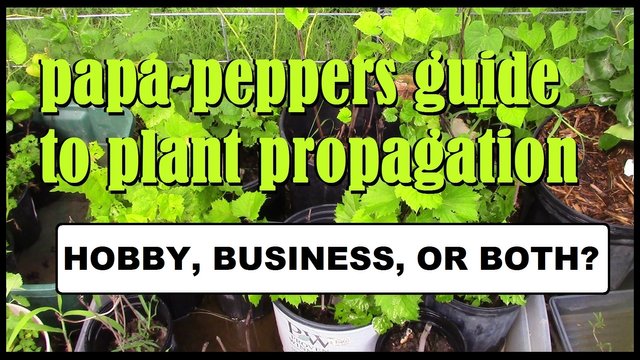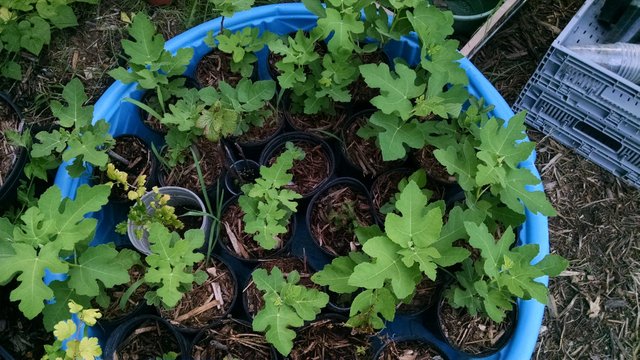papa-peppers guide to plant propagation – Hobby, Business, or Both?

You’ve probably seen some of the edible rewards that I’ve been blessed with by gardening and foraging. Today I’ll also be discussing another potential byproduct of growing your own food producing plants, money. Simply put, food is worth money. If you have plants that can make food, others may be willing to give you money for them. People buy all sorts of plants every day. Here’s a few simple examples to get your creative juices flowing.
PERENNIALS
Perennials are plants that come back year after year, like most shrubs and trees. You do not need to plant another one to get another one next year. The same plant will either still be there or regrow. You can sometimes get a lifetime of return on the initial investment of planting a perennial.

Fig Tree - Multiple Years Old
Take a fig tree for instance. The one pictured is supposedly around 5-7 years old. I believe that it is a Brown Turkey Fig. Usually, it dies back to the ground every year, and regrows again in the spring. Last winter, it didn’t die back, so it’s already huge.
Anyways, using this tree as an example, I’ll illustrate my point. A conservative estimate of propagating this plant by cuttings would be 200. That means that I believe that I could get an easy minimum of 200 cut pieces off of this particular fig that I could try to get to grow into new fig trees.

Propagated Figs
Here’s an example of what some successfully propagated fig tree cuttings look like. Anyway, I think that I could make 200 cuttings minimum off of this one tree. (Not to mention the one behind it.) Now let’s say that only half of my attempted cuttings survive. That’s still 100 new trees that I have. A quick google search shows me that Brown Turkey Fig Trees are currently selling online for about $17 - $70. Since I’d be entering some sort of preexisting market (meaning that others are already selling these trees), I think undercutting the competition would be a good idea, so I’ll have to sell for less. After all, I have no established business, household name, customer reviews, or fantastic website. Starting off small and slow, let’s say that I choose to attempt to sell the 100 fig cuttings that survived for $10 each. Using word-of-mouth, craigslist, and posting flyers at local businesses, I attempt to sell them all. If 50 people each buy one, I’ve only sold half of my inventory, but I’ve made $500. If I use free soil, free pots, and free cuttings, my financial investment was $0. All $500 would be profit. (Trust me, free pots and free soil are not that hard to come by.)
What about the rest of the plants? If I keep them, they’ll be bigger next year, and I could charge more when I sell them. Or, I could make more cuttings off of them, and make more plants. If no one buys them, I can keep them and eat the fruit, and then sell them for more next year or propagate more, allowing the process to repeat itself. I know that this sounds interesting, but is also something that the vast majority of people would never really end up doing. That’s why it works. Ones who won’t will often pay the ones who will. In the end, as long as people will still buy them, you’re basically printing money.
ANNUALS
Annuals are plants that only live for a season. Generally, you’ll plant them in the spring, and by winter they’ll be dead, never to be seen or heard from again. (Unless they reseed themselves.) Common annuals include flowers like the Marigold and vegetables like Squash or Tomatoes. These can be a good option for making some money, and food as well.

A Super-Hot Pepper Plant
I will use a pepper plant as an example, because I’m @papa-pepper. Let’s say that you buy a Carolina Reaper Hot Pepper Plant at a garden store or local greenhouse. The Carolina Reaper has recently been the reigning champ for hot peppers, having a Scoville Heat Unit reading of over 2 million. Let’s say that the plant produces 50 peppers and that each pepper has 4 seeds. (Again, I’m going with a very conservative production rate to give you a “worst case scenario” here.) You can eat the 50 peppers, dehydrate them, use them in salsas, or give them away, but let’s say that you keep the seeds. 50 peppers with 4 seeds each is 200 seeds. If you plant them all the following February or March (start them early and they’ll be bigger sooner) and only half sprout, you’ve still got 100 seedlings. Now hot peppers are a hot item. I was selling Ghost Pepper seedlings at a garage sale for $5 EACH. YES, $5 EACH!!! Perhaps you’re not as ambitious though and attempt to sell yours for $1 each. If you sell the all, you’ll make $100. Not bad for sticking seeds in the dirt in your free time. If no one buys the seedlings, since they are annuals, you’d better plant them. If you plant them all and they produce at the same conservative level of 50 peppers per plant, you’ll have 500 peppers come harvest time.
I’ve seen Ghost Peppers selling for 50 cents each in grocery stores, so Carolina Reapers, which are twice as hot, should be able to do the same. If the grocer wants to double his money, he’d only be willing to pay 25 cents per pepper. If you sell him all 500, that’s $125 in your pocket. If he doesn’t buy though, you’re going to have to eat them too and save your seeds once again. Now 500 peppers each with 4 seeds is not only a conservative number, it’s also 2000 seeds. I just checked online and the worst price available for buying them was about 1 cent per seed. This is a very low price, so let’s say that you offer yours above the bottom selling price and still undercut a lot of the competition, offering yours 10 for $1, or 10 cents each. If you sell them all, that’s $200. Or, you could sell some and plant the rest to sell as seedlings next year, and let the process continue.
THE POINT
At least at a hobby level, getting paid for gardening is not a bad idea. Food is always a necessity, and people have to get it from somewhere. If they are going to be buying it, why not offer to let them buy it from you. If you really like a certain type of vegetable, plant extra. When the seedlings are ready, plant the best ones for yourself and sell the rest. If you plant more than you need, sell the extra produce. Or, you could give it away to bless others or trade with people for other things that you need. The options are almost limitless, but not having food is not an option. Once way or another, you’ll have to get some, and so will others.
Personally, I want to get to the point that I don’t need to work away from my family to earn an income. I desire to be able to do something from home, so I am available to my wife and children all day long. Perhaps steemit will play a role in this, and I think that it already has. But no man would be wise to put all his eggs in one basket, so perhaps plant propagation will be another basket for me. Perhaps it even could be for you. Try some planting or other propagation methods and see if you like it. Keep practicing, and if you wind up with a lot of plants, then you’ll have a lot of options.
As always, you’ll need a market, but in many ways, the internet has provided everyone everywhere with just that. Maybe it is not an outlet for the distribution of fresh produce, but seeds and plants are shipped across the county and around the world daily, just watch out for those pesky customs laws when dealing internationally.
This was meant to be a simple business idea of a potentially viable opportunity for many of us. It is not professional career advice, but hopefully it is some good food for thought. Others are doing it, and I’m joining them. If you want to, you can join us too.
Here’s the previous posts from the papa-peppers guide to plant propagation series:
Introduction
Passionfruit & Elderberry
Kiwi, Goji Berry, & Dates
Pitaya & Prickly Pear
Grapes & Figs

Your post is both interesting and inspiring! I am very interested in the topic of gardens promoting health. I just wrote an article about how Gardens at hospitals or clinics can reduce anxiety, anger and depression. I would appreciate you having a look at it and sharing your comments.
http://steem.link/2t4us
Thanks for the info papa-pepper...another great post
Thanks for another encouraging reply !
Good post. Reminds me I ran out of Thai Dragon shake pepper, I need to see if I can grow some more throughout the winter in wood heated home. (temp fluctuations). Last time I dried and ground up I used my sons coffee grinder, (note to self, rinsing grinder not enough, use detergent). My son`s got no sense of humor.
Ah yes, the Thai Dragon. I have met that pepper before, and I won. I once gave some Ghost peppers to a lady who cooked with them. The next time she used that same pan, the food had the same heat level. Man were they surprised! I guess when she was cooking the first batch her dogs even started coughing and left the room.
I am a very amateur gardener. I just started playing around with it this year but had some great success with various leafy greens and cucumbers. I'm up to my neck in pickles! I enjoyed your post. Very informative.
I'm up to my neck in cucumbers too, and pickling them like crazy to save the extra for winter. It certainly is rewarding, I'm glad you're starting up. Check out any of my previous posts for more info on what we've been up to. There will be more to come.
Haha! Lol, love your stuff papa-pepper! Keep up the great work , in glad I follow you ! 😉👍👆

Great ideas. There's no end to what you can do, if you can find a market.
We get volunteer pecan trees all over our yard. This winter I think we'll pot them when they're dormant and sell the ones that leaf out in the spring. We have some fig trees growing now too, as well as mulberries, both easy to propagate from cuttings. I was shocked at how well our white mulberry rooted. It's just a few months old and already over 5' tall! nom nom nom. We got one pluot that way too. Never hurts to just take cuttings and stick them in the ground. They'll either root or compost = win/win. :)
ROOT OR COMPOST = WIN WIN - I totally agree, and appreciate the adventure that you are on. Mulberries are soooo good. We used to make a lot of smoothies with them 12 or 13 years ago, I've got to get some of them around here.
Remind me this winter when they're dormant and I'll send you some cuttings. I have the White Pakistan, Teas Weeping and just a basic rootstock that I'm not sure about. I'll be learning how to graft onto that one.
Cool, and THANX! I'll be covering grafting techniques shortly, most likely right after layering.
Awesome post man! Kind regards
Thanks, some people think that I've had a lot of "awesome" posts, and I'm glad you two are "one" of them!